The January 2021 transfer window has been one of the quietest we can remember. The effects of the pandemics have forced clubs to save money and play it safe with their recruitment, limiting it mostly to free transfers, loans or very low fees.
But some clubs have decided to plan in the longer term and have already started looking for players for next season. In this tactical analysis, we’ll provide a scout report on five U21 players who have already secured a move to big clubs for next summer and see how they could adapt to their tactics and their potential to become top players and prove to be excellent signings.
Kluiverth Aguilar (17) – Alianza Lima to Man City
Kluiverth Aguilar is a 2003-born Peruvian defender who started his youth career at Sporting Cristal, joining Alianza Lima in 2019. He has played 27 matches for the first team both in the Peruvian league and the Copa Libertadores and has also represented Peru at U17, U20 and U23 levels despite being just 17.
Man City bought him for €2.5 million but he’s not expected to make an immediate impact in the first team so a loan or a spell at the club’s U23 squad seems the most likely situations next summer. In this scout report, we’ll see why the City Group has decided to make this investment in an underage Peruvian talent.
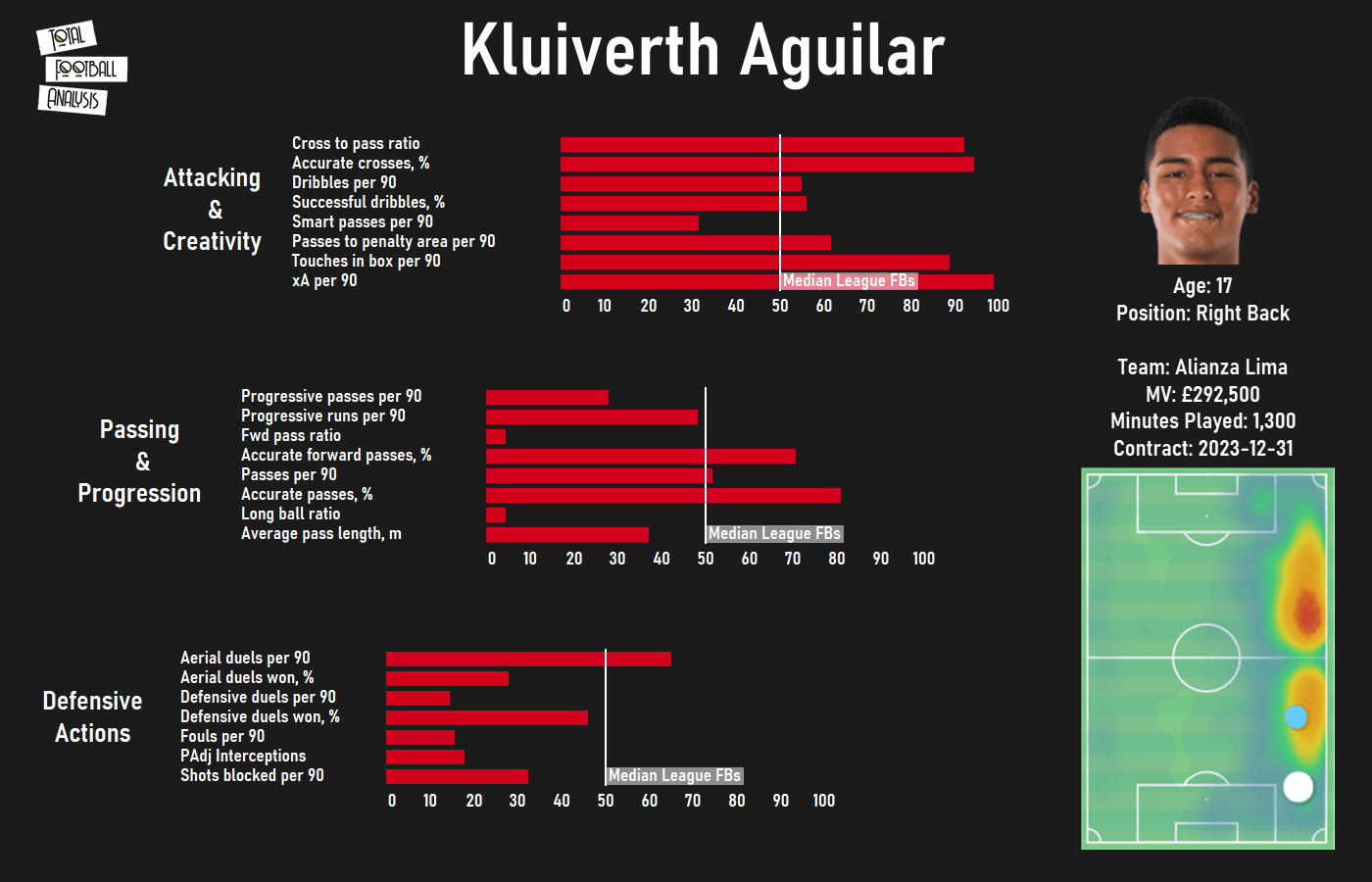
Aguilar is right-footed, stands at more than 180 cm and is well-built, very quick and powerful. Once he starts running he’s very difficult to stop and can make long efforts at maximum speed very often.
His main characteristic is his presence in the final third and the box. Aguilar is very energetic getting forward and can dribble past players when he has some space using his speed. He makes lots of very good crosses and passes to the box, amounting to 0.17 xA per 90, an excellent figure for a full back. He’s also a good dribbler in tighter spaces but it’s not his main strength.
Aguilar usually keeps his passes short and simple, putting the correct weight into them. He likes to pass and move, advancing with runs without the ball and making overlapping or underlapping runs from deep positions taking advantage of his pace to get away from rivals.
Sometimes he makes some questionable decisions and puts his team into challenging situations where they’re easily pressed. He also makes some mistakes in his own half when pressed as he tries to drive the ball forward through central positions between several rivals. At his current club that is an issue as his teammates aren’t always ready to pass the ball back to him or create spaces for his runs but playing at a higher level alongside technical players like Man City’s, Aguilar will find someone who can play quick combinations with him even under lots of pressure.
PLaying for a dominating team means Aguilar isn’t very involved in defence. He doesn’t have too much defensive responsibility because there’s usually someone who covers his back as he plays as a wing-back with three centre-backs or with a midfielder always ready to fill in his position when he’s attacking. Anyway, he’s strong in duels, uses his physicality to push rivals off the ball and covers space to block shots and crosses with his long legs. Because of his pace, he’s very difficult to dribble past as he recovers quickly.
Aguilar is physical, has good timing and makes decisions in attack while having a solid technique. He will probably leave on loan before getting a first-team opportunity to adapt to European football but for just €2.5 million he’s a good gamble and will probably justify Man City’s investment.
Kamil Piątkowski (20) – Raków Częstochowa to RB Salzburg
Kamil Piątkowski is a 2000-born Polish defender who was at Zaglebie Lubin until 2019 but only played with their B team. In 2019, he joined Raków Częstochowa and has played 45 games in all competitions since then. He has represented Poland at U15, U19 and U20 levels and now he’s part of the U21 national team.
Anticipating his potential but also considering his current level, RB Salzburg have been quick to secure his services for next season after paying €5 million. He’s the most expensive sale of his club, with the second one being just €350k. He’s expected to be part of the RB Salzburg squad next season as he continues his development while adapting to his new team’s tactics.
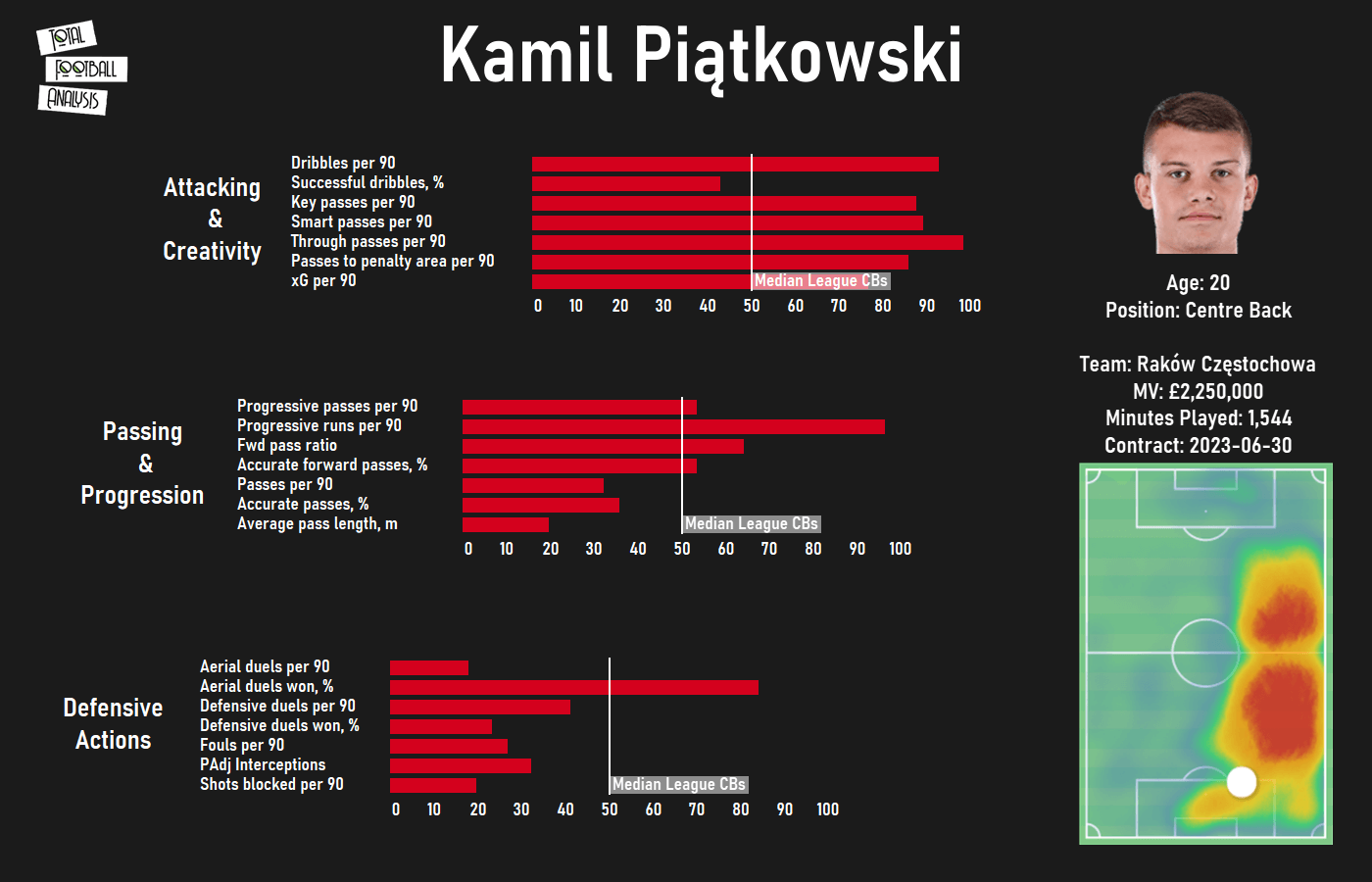
Piątkowski (right-footed) usually plays as the right centre-back in a back-three, with the freedom to press high, try to recover the ball in the opposition half and venture forward in possession. His heatmap shows how much ground he covers both in attack and defence because of his unique playing style.
Standing at 191 cm, Piątkowski is a very strong and well-built centre-back who uses his body very well to limit the strikers’ movements. Despite his size, he’s quick and feels comfortable playing in a high line and trying to anticipate instead of retreating to his box.
His first instinct when his team loses the ball is going forward and trying to recover it as quickly as possible. Playing in a back-three allows him to leave his theoretical position and take more risks and he’s very good at it. His relatively low success rate in defensive duels comes from this high risk-reward defending style as he gets forward very aggressively and tries to anticipate before the rival’s attack even starts. He’s also excellent in the air because of his physicality.
When in possession, Piątkowski likes to get forward and play in the opposition half. He’s very comfortable and confident running with the ball, he advances until he attracts a rival and then chooses a good passing option to continue advancing. After passing, he likes to run forward, either overlapping the winger or through central positions to create numerical advantages or get into the box and be a possible target for crosses. He creates a lot in the final third when he gets forward considering he’s a centre-back. When the rivals press high, he can put long passes over the defensive line and into the final third.
His technique is enough to take advantage of his determination and power going forward but he isn’t the most refined passer or dribbler in tight spaces so he needs to start his runs from deep in order to have enough space to create danger. He relies on his physicality and his determination to attack free spaces from deep positions. He would be very useful in dominating sides that usually play against low blocks as his runs force the rivals to make decisions and move from their positions, creating spaces for the rest of his teammates.
Piątkowski is an intriguing player. Centre-backs are getting more and more complex and he has shown he can change games if given the appropriate context. It will be interesting to see whether RB Salzburg play him in the same role and position he’s been playing at or try to adapt him into a more classical role.
Aster Vranckx (18) – KV Mechelen to Wolfsburg
Aster Vranckx is a 2002-born Belgian midfielder who has been at KV Mechelen for his whole career. Since his debut aged just 16, he has 34 games for the first team and is getting more and more important. He’s part of the Belgium U21 squad and has also represented his country at the U19, U16 and U15 levels.
Wolfsburg have paid €8 million for him so he’s expected to have a role at their first team from next season. In this tactical analysis, we’ll see how he can contribute to his new team.
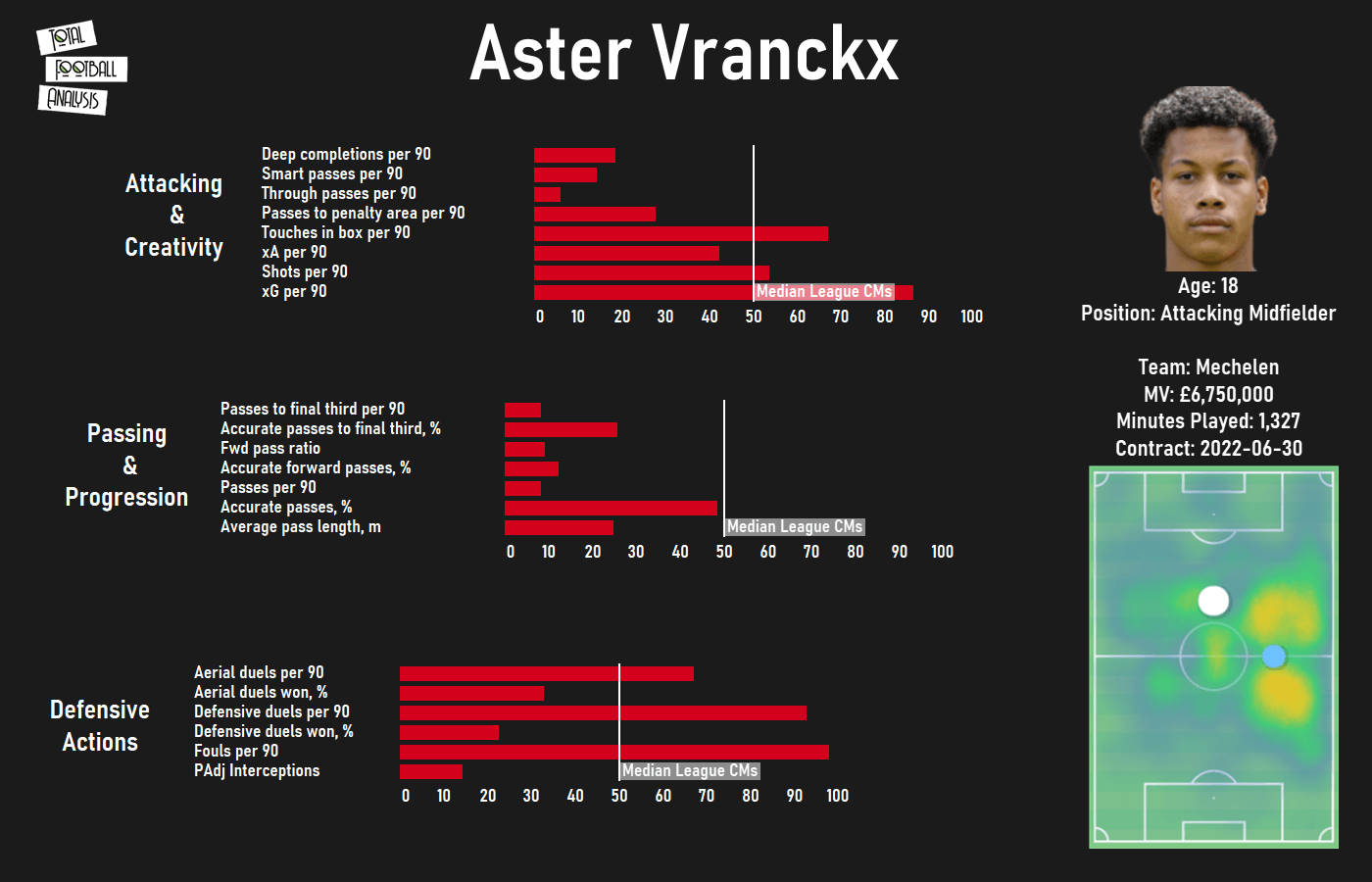
Vranckx is a right-footed central midfielder who can be used in different roles and tactics. He has played as the deepest man in a midfield trio but his best position is slightly higher, be it as the attacking midfielder in a 4-2-3-1 or as a central midfielder in a 4-3-3. From these more advanced positions, he can exploit his runs from the second line.
He has a good size standing at 183 cm. He’s also athletic, strong and has a good work rate. He may look a little bit heavy in some actions and even if it’s his body type he could gain some agility to improve his game.
Despite being a central midfielder, Vranckx isn’t very involved in the buildup or the organization. He plays mostly simple passes and contributes to his team with his off-the-ball movements. He makes lots of runs from midfield into the box both taking advantage of the available space or creating it for his teammates. The timing and speed of his runs are very good and show an attacking positioning much better than the average at this age.
He gets into the box often and into dangerous positions as evidenced by his 1.56 touches in the box, 1.09 shots and 0.2 xG per 90. It’s interesting to note that Vranckx doesn’t try his luck from difficult positions or adds to his xG with speculative shots. From his amazing 0.18 xG/shot, we can deduct he reads the game well and knows where to be to get chances and also when to shoot to maximize his outcome.
Vranck possesses a solid technique, a good first touch and can handle the ball in tight spaces. He’s not especially creative or skilled in one-vs-one situations and doesn’t have the vision or quality to assist his teammates with intricate passes but his presence in and around the box gives him the opportunity to make some simple passes into dangerous positions and get some assists.
His defensive work is good in general but could be more consistent. He likes to counter-press and has the physical conditions to win duels but sometimes he doesn’t track back as quickly as he could or is too reactive instead of trying to anticipate. There’s room for improvement in this department but it isn’t worrying considering he’s only 18.
Vranck isn’t a player who catches the eye with fancy tricks or excellent quality details. His main strength lays in his movements and ability to get goals from midfield but without getting involved too much in the attacks. His role in attack could be compared to Tomáš Souček’s at West Ham, even if the Czech has a wider range of duties. He will continue his development at a higher level in the Bundesliga, where the higher tempo of the games will be a nice challenge for him.
Marcos Paulo (21) – Fluminense to Atlético de Madrid
Marcos Paulo is a 2001-born Brazilian forward who has always been at Fluminense, coming through their academy and making 77 appearances so far for the first team (14 goals). He also holds a Portuguese passport and has decided to represent them at an international level, having been part of the U18 and U19 Portuguese national teams.
Atlético de Madrid have signed him for next season but the terms of the agreement aren’t clear. His contract is over in the summer but it’s rumoured the Spanish club will still pay some compensation to Fluminense to bring the promising forward to La Liga. In this analysis, we’ll see what he could contribute to Atlético Madrid’s tactics.
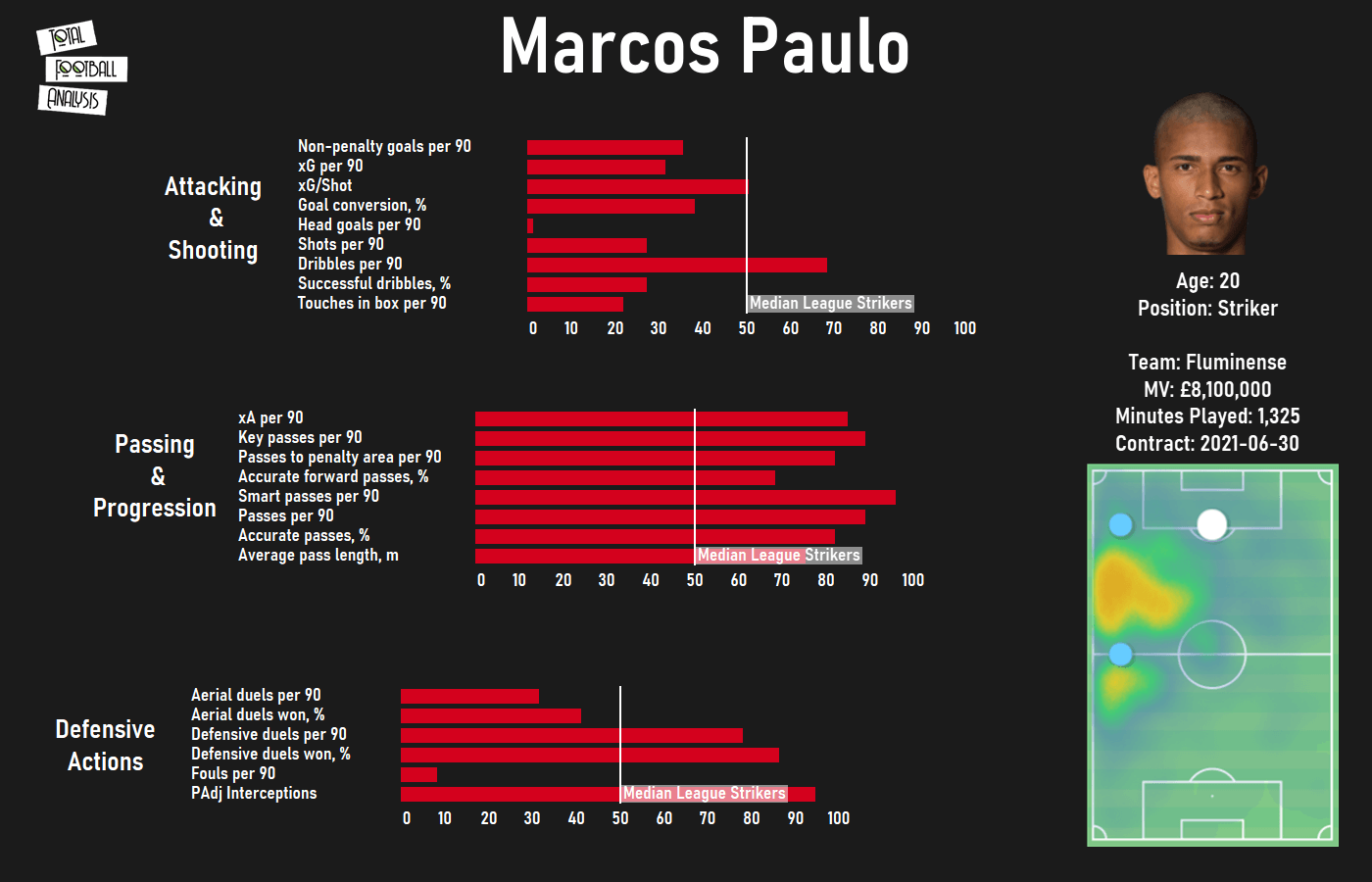
Marcos Paulo stands at 186 cm, is strong to play with his back to the goal, well-coordinated and has good pace even if he’s not explosive or someone who will beat players just with his acceleration.
A right-footed forward, he drifts left very often but gets into central positions as the play advances, occupying any position on the left side of the pitch. The low tempo of the Brazilian league makes him want to receive the ball to his feet, get involved a lot in the attacks and play lots of lateral and backwards passes, contributing to a high passing accuracy of 83.7%.
Marcos Paulo is a very Brazilian player. He has a very good technique, great first touch and ability to play quick combinations in tight spaces even when he’s using his body to hold defenders. When he receives the ball in the left half-space he has excellent vision to progress into the final third with accurate passes and also to create chances. He’s creative to find passing options against low blocks, switch the game when there’s space on the right side and assist the strikers with good balls over the defensive line. He’s skilled in one-vs-one situations but doesn’t look to take on his man very often. He mostly uses his dribbling to get out of pressure and create space to play his passes.
This quality to create is reflected in his passing and progression stats. He’s in the top 20% of the Brazilian Serie A strikers in passes to the box per 90 (2.17) and xA per 90 (0.16). He still doesn’t have the dynamism to get into the box after acting as a playmaker, which explains his low shots and xG figures. With just 0.22 xG per 90 in the league since his debut, Marcos Paulo is still expected to contribute with more goals.
But he needs to be more direct and dynamic. Sometimes, he has the chance to advance and initiate a counterattack but prefers to wait for the defenders to recover his position, takes many touches and lets the opportunity slip. He would improve his game if he made more runs in behind and tried to get forward when there’s space in front of him. This also translates into his defensive work as he’s capable of using his physicality to win duels high up the pitch but doesn’t counter-press as quickly as he should. Simeone will surely work on these aspects to get the best out of his talent.
Marcos Paulo has some very interesting characteristics, both physical, technical and mental, that make him a promising player for the future. His young age and the Brazilian playing style make it difficult to imagine him in a high-intensity and quicker football like Atlético de Madrid’s but he’s still a teenager and has time to adapt to their tactics. Getting him on a free, especially considering he holds an EU passport, is a smart move and it will surely pay off in the future.
Ali Akman (18) – Bursaspor to Eintracht Frankfurt
Ali Akman is a 2002-born Turkish forward who has spent his whole career at his current club, Bursaspor. Since his debut in 2019, Akman has played 45 games for Bursaspor in the Turkish second division and the cup, scoring 14 goals. 11 of those goals came this season in 20 matches, attracting attention from the bigger leagues. Akman has also played for Turkey at U15, U16, U17, U18, U19 and U21 levels, with a total of 40 youth caps and 20 goals so far.
With his contract running out in June 2021, Eintracht Frankfurt have been quick to secure his signing on a free. Considering the club’s record of converting relatively unknown players into world-class strikers (Luka Jović, Sébastien Haller…), Akman seems to have a bright future ahead of him.
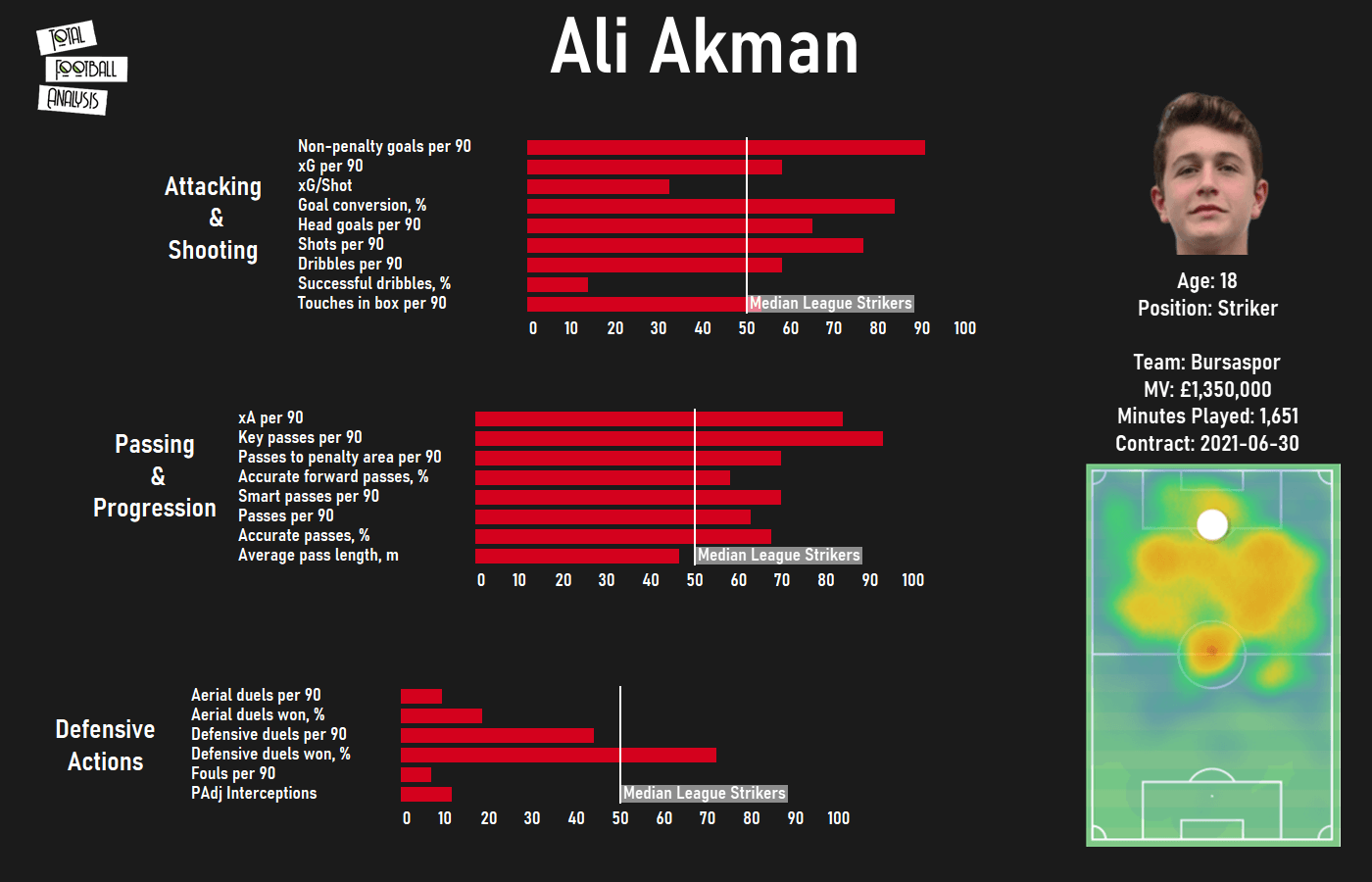
Akman is a right-footed striker whose playing style could remind us of Liverpool’s Roberto Firmino as he doesn’t stick to his striker role and roams around the opposition half to be the focal point of Bursaspor’s attacks. He usually comes deep to play between the lines and in the half-spaces, looking to receive progressive passes and put his teammates into play. His heatmap is good evidence of his versatility and work rate in attack.
Standing at 174 cm, Akman’s physical conditions are quite surprising. While he has good acceleration, his pace over longer distances is just ok. He’s very lively and agile, always moving and a dynamic and tireless worker to find and create spaces. Despite his small size, he’s quite strong to resist challenges and play with his back to the goal and also combines good jumping power with good timing to fight for aerial balls.
Akman’s technique is more than a very solid technique. His excellent first touch combined with his body shape allows him to play quickly and leave defenders behind without really dribbling them. He shows excellent quality in his layoffs to put teammates into play when playing with his back to the goal with first-touch passes using his chest and different surfaces of his feet, including the backheel. He scans his surroundings before receiving the ball and decides quickly what to do so he’s not easily pressed and dictates the tempo of the attacks.
Always with a perfect body orientation to move the ball quickly into free spaces and keep the attacks fluid, Akman opens the game to the wings and then attacks the box with late intelligent runs. When he’s facing the goal he has the vision and technique to make through passes with excellent timing and assist his teammates, especially the wingers who make diagonal runs in behind. This quality and vision translate into 0.14 xA per 90, a very good figure for a striker, especially considering his scoring record.
Once he’s in the box, he makes good little movements to create space between him and the defender so once he receives the ball he has space to shoot. He’s lively in short distances, capable of creating a yard of space to shoot and also reacting quickly to any rebound to score the tap-in. His finishing is excellent and very diverse. He can lob the goalkeeper with delicate touches, score from volleys, place the ball accurately by the post, shoot with power from distance… and all that with both feet! This has led him to score 0.55 goals from 0.35 xG per 90 with a conversion rate of 22%, and given the quality of his finishing, it seems plausible that he continues overperforming his xG.
In Akman we find a very rare gem. He’s an excellent goalscorer with the necessary instinct and finishing ability to succeed at the highest level. But apart from that he’s a true playmaker outside the box, understands the game and has a lot of time until reaching his peak as he’s only 18. Getting him on a free could prove to be a masterstroke for Eintracht, who will now need to develop and coach him correctly to create a top player for the Bundesliga.
Conclusion
Moving early in the market can secure excellent signings for clubs that they wouldn’t be in a position to sign in the summer. Not only players whose contracts are over in the summer are interesting to sign months in advance, but also young players whose value is expected to increase week after week can be signed for a lower fee if agreed in advance.
Of course, this strategy also carries its risks. Players can get comfortable knowing they’ve already got a contract at a higher level, clubs can decide against playing them as they won’t be able to benefit from developing them or they could simply get injured. Balancing these risks and making sure both clubs have a good relationship is key to success in these operations.




Comments